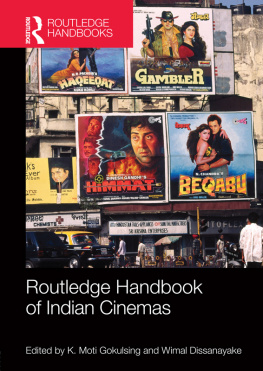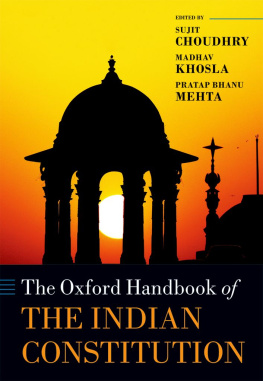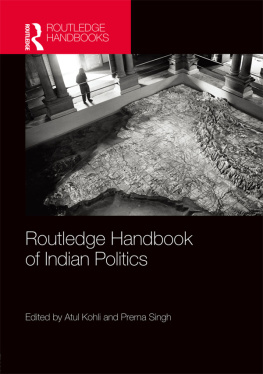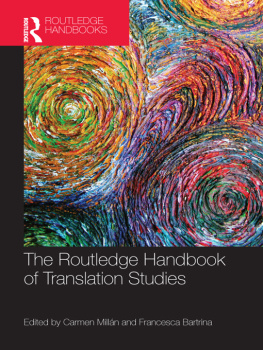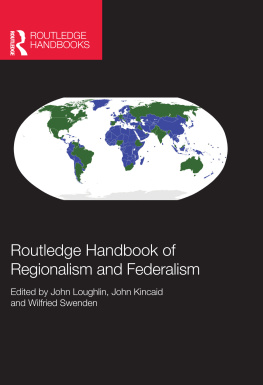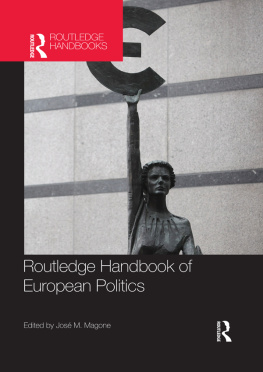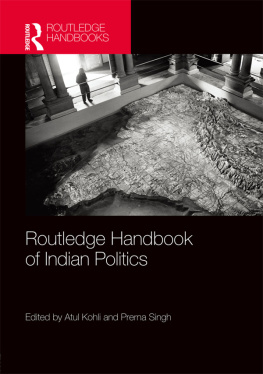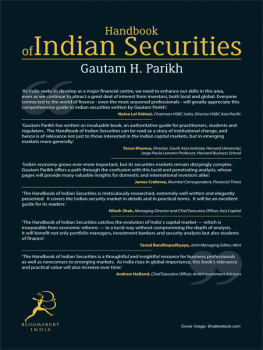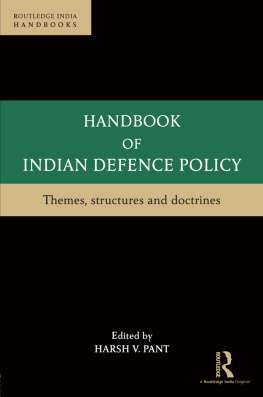Gokulsing - Routledge Handbook of Indian Cinemas
Here you can read online Gokulsing - Routledge Handbook of Indian Cinemas full text of the book (entire story) in english for free. Download pdf and epub, get meaning, cover and reviews about this ebook. publisher: Taylor & Francis Ltd, genre: Politics. Description of the work, (preface) as well as reviews are available. Best literature library LitArk.com created for fans of good reading and offers a wide selection of genres:
Romance novel
Science fiction
Adventure
Detective
Science
History
Home and family
Prose
Art
Politics
Computer
Non-fiction
Religion
Business
Children
Humor
Choose a favorite category and find really read worthwhile books. Enjoy immersion in the world of imagination, feel the emotions of the characters or learn something new for yourself, make an fascinating discovery.
Routledge Handbook of Indian Cinemas: summary, description and annotation
We offer to read an annotation, description, summary or preface (depends on what the author of the book "Routledge Handbook of Indian Cinemas" wrote himself). If you haven't found the necessary information about the book — write in the comments, we will try to find it.
Routledge Handbook of Indian Cinemas — read online for free the complete book (whole text) full work
Below is the text of the book, divided by pages. System saving the place of the last page read, allows you to conveniently read the book "Routledge Handbook of Indian Cinemas" online for free, without having to search again every time where you left off. Put a bookmark, and you can go to the page where you finished reading at any time.
Font size:
Interval:
Bookmark:
ROUTLEDGE HANDBOOK OF INDIAN CINEMAS
India is the largest film-producing country in the world and its output has a global reach. After years of marginalization by academics in the Western world, Indian cinemas have moved from the periphery to the center of world cinema in a comparatively short space of time. Bringing together contributions from leading scholars in the field, this Handbook looks at the complex reasons for this remarkable journey.
Combining an historical and thematic approach, the Handbook discusses how Indian cinemas need to be understood in their historical unfolding as well as their complex relationships to social, economic, cultural, political, ideological, aesthetic, technical and institutional discourses. The thematic section provides an up-to-date critical narrative on diverse topics such as audience, censorship, film distribution, film industry, diaspora, sexuality, film music and nationalism.
The Handbook provides a comprehensive and cutting-edge survey of Indian cinemas, discussing Popular, Parallel/New Wave and Regional cinemas as well as the spectacular rise of Bollywood. It is an invaluable resource for students and academics of South Asian Studies, Film Studies and Cultural Studies.
K. Moti Gokulsing is Senior Visiting Research Fellow at the University of East London, UK. He is the co-founder and co-editor of the journal South Asian Popular Culture published by Routledge. His publications include Soft-Soaping India: The World of Indian Televised Soap Operas (2004).
Wimal Dissanayake teaches at the Academy for Creative Media at the University of Hawaii, USA. He has published widely on Indian cinema, and is co-editor of Popular Culture in a Globalised India (Routledge, 2009) with K. Moti Gokulsing.
ROUTLEDGE HANDBOOK OF INDIAN CINEMAS
Edited by
K. Moti Gokulsing and Wimal Dissanayake
Editorial Assistant Rohit K. Dasgupta

First published 2013
by Routledge
2 Park Square, Milton Park, Abingdon, Oxon OX14 4RN
Simultaneously published in the USA and Canada
by Routledge
711 Third Avenue, New York, NY 10017
Routledge is an imprint of the Taylor & Francis Group, an informa business
2013 K. Moti Gokulsing and Wimal Dissanayake
The right of the editors to be identified as the authors of the editorial material, and of the authors for their individual chapters, has been asserted in accordance with sections 77 and 78 of the Copyright, Designs and Patents Act 1988.
All rights reserved. No part of this book may be reprinted or reproduced or utilised in any form or by any electronic, mechanical, or other means, now known or hereafter invented, including photocopying and recording, or in any information storage or retrieval system, without permission in writing from the publishers.
Trademark notice: Product or corporate names may be trademarks or registered trademarks, and are used only for identification and explanation without intent to infringe.
British Library Cataloguing in Publication Data
A catalogue record for this book is available from the British Library
Library of Congress Cataloging in Publication Data
Routledge handbook of Indian cinemas / edited K. Moti Gokulsing and Wimal Dissanayake.
pages cm
Includes bibliographical references and index.
1. Motion picturesIndiaHistory. 2. Motion picture industryIndiaHistory. I. Gokulsing, K. Moti, editor of compilation. II. Dissanayake, Wimal, editor of compilation.
PN1993.5.I8R63 2013
791.430954dc23
2012038673
ISBN: 978-0-415-67774-5 (hbk)
ISBN: 978-0-203-55605-4 (ebk)
Figures
Tables
The editorial board
- Richard Allen, Professor of Cinema Studies, New York University, USA
- Sumita Chakravarty, Associate Professor, New School for General Studies, USA
- Farrukh Dhondy, filmmaker, playwright and writer
- Amir Ullah Khan, Dean and Director of Research, Bangalore Management University, India
- Vijay Mishra, Professor of English and Comparative Literature, Murdoch University, Australia
- Ashis Nandy, Honorary Senior Fellow and Former Director, Centre for the Study of Developing Societies, India
- Rosie Thomas, Director of India Media Centre, University of Westminster, UK
The editors
K. Moti Gokulsing is Senior Visiting Research Fellow at the University of East London. He is the co-founder and co-editor of the journal South Asian Popular Culture published by Routledge. His publications include Soft-Soaping India: The World of Indian Televised Soap Operas (2004); co-author of Indian Popular Cinema: A Narrative of Cultural Change (1998, 2004); co-editor of Popular Culture in a Globalised India (Routledge, 2009); and co-author of From Aan to Lagaan and Beyond: A Guide to the Study of Indian Cinema (Trentham Books, 2012).
Wimal Dissanayake is a professor at the Academy for Creative Media, University of Hawaii and is a member of the Graduate Faculty of the Department of Political Science. He is also the Director of the International Cultural Studies Program of the University of Hawaii. Dissanayake is the author and editor of a large number of books on cinema that have been published by the Oxford, Cambridge, Duke, Minnesota and Indiana University Presses. The book Indian Popular Cinema: A Narrative of Cultural Change, co-authored by K. Moti Gokulsing and Wimal Dissanayake, is widely used in higher seats of learning on both sides of the Atlantic. He is the founding editor of the East-West Film Journal and also a General Editor of a series of books on Hong Kong cinema published by the University of Hong Kong Press.
Rohit K. Dasgupta, the Editorial Assistant, is Associate Lecturer and doctoral scholar at the University of the Arts London. He had lectured at the University of Westminster, and University of West London.
Contributors
Adrian Athique is author of The Multiplex in India: A Cultural Economy of Urban Leisure (Routledge, 2010, with Douglas Hill) and Indian Media: Global Approaches (Polity Press, 2012). He is also the author of Digital Media and Society: An Introduction (2013, Polity Press).
Steven Baker is an academic and journalist who divides his time between the UK and India. He has a Masters degree in South Asian Area Studies from the University of Londons School of Oriental and African Studies (SOAS). Steven has lectured at Birkbeck University and the University of East London and writes on cinema for online and print media. Steven spoke on Foreigners in Bollywood at the inaugural TEDx Mumbai. He has also appeared in 20 Bollywood films.
Shakuntala Banaji is a Lecturer in Media and Communications at the London School of Economics and Political Science. Recent books include South Asian Media Cultures: Audiences, Representations, Contexts (Anthem Press); and The Civic Web: Young People, Civic Participation and the Internet in Europe (MIT Press, with David Buckingham).
Manoj Barpujari, film critic, poet and journalist, is a member of the international film and critics federation, FIPRESCI. He has co-edited a comprehensive study book Perspectives on Cinema of Assam (2007), and published nine books on politics, literature and cinema. A national award-winning film critic in India, he received a journalism fellowship in Trinidad and Tobago. His poems are translated into several major Indian languages.
S. Theodore Baskarans book The Message Bearers (1981) is a standard reference work on early south Indian cinema. His other book,
Next pageFont size:
Interval:
Bookmark:
Similar books «Routledge Handbook of Indian Cinemas»
Look at similar books to Routledge Handbook of Indian Cinemas. We have selected literature similar in name and meaning in the hope of providing readers with more options to find new, interesting, not yet read works.
Discussion, reviews of the book Routledge Handbook of Indian Cinemas and just readers' own opinions. Leave your comments, write what you think about the work, its meaning or the main characters. Specify what exactly you liked and what you didn't like, and why you think so.

